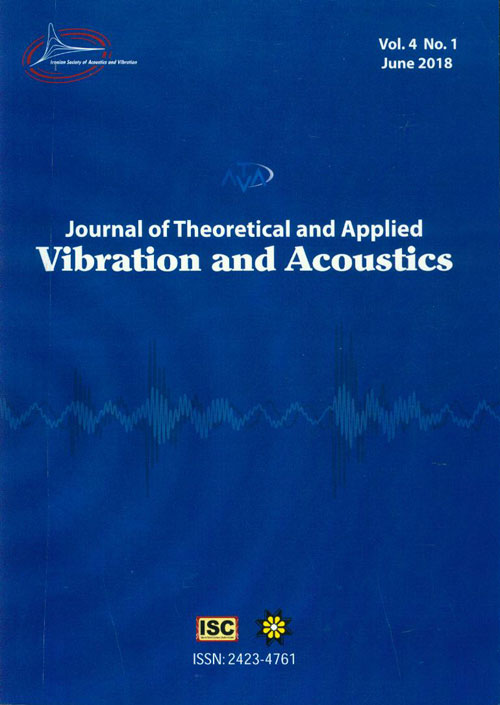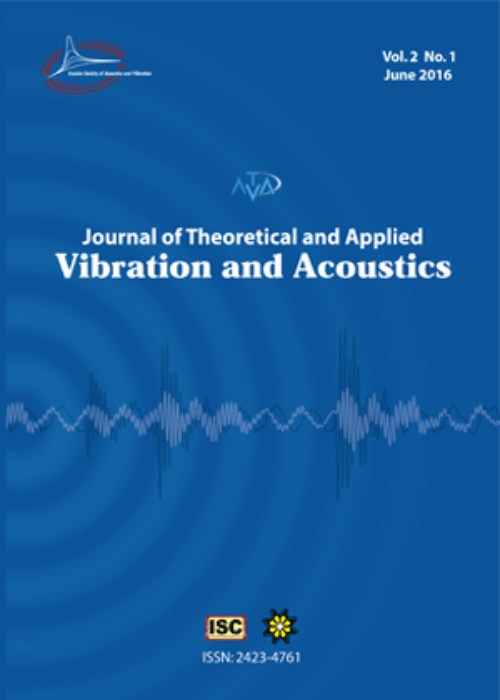فهرست مطالب

Journal of Theoretical and Applied Vibration and Acoustics
Volume:4 Issue: 1, Winter & Spring 2018
- تاریخ انتشار: 1397/01/20
- تعداد عناوین: 6
-
-
Pages 1-18The present article investigates effects of the multi-frequency excitation on the output power of a piezomagnetoelastic energy harvester. The piezomagnetoelastic power generator is assumed to operate in the mono-stable mode. A perturbation technique based on the method of multiple scales is employed to develop an analytical solution to nonlinear differential equations governing the system dynamics. In addition, a Runge-Kutta numerical scheme is used to solve the differential equations. It is shown that the perturbation solution is in a close agreement with the numerical solution. The system response is determined for several cases including super-harmonic, combination and simultaneous resonances. The steady-state output voltage is then obtained for each case and compared with that of a single-frequency excitation. Due to nonlinearities present in the system, a multi-frequency excitation gives rise to complicated phenomena such as combination and simultaneous resonances. It is found out that exploiting these resonances can significantly increase the amount of energy harvested.Keywords: Energy Harvesting, multi-frequency excitation, method of multiple scales, piezomagnetoelastic
-
Pages 19-36In the present paper, the dynamical snap-through of a preloaded micro-sensor is analyzed. This behavior is linked to analyzing bifurcation behavior of the micro structure in a suitable framework. Effects of the axial pre-stress and the excitation amplitude on the stability and sensitivity of the sensor are also discussed. In order to capture the size effects, the modified strain gradient theory is employed on an Euler-Bernoulli beam. Applying the Hamiltons principle and utilizing the Galerkins method, the nonlinear governing equation for the vibration is obtained. The method of multiple scales (MMS) is then used to obtain the frequency-response equation and by using a mathematical approach, the bifurcation points and the jump heights of the micro-resonator are analyzed. The calculated analytic equation for frequency response, provides the conditions for obtaining the range of snap-through and studying the effects of different designing parameters on the multivaluedness range. The jump height of the micro-resonator is proposed to use as a criterion for sensing purposes. The simulations are illustrated and the results are verified with similar worksKeywords: MEMS, Bifurcation, Modified Strain Gradient, Stability, Nonlinear Vibration
-
Pages 37-64This paper presents the effect of distance and dimensions of magnetson chaotic behavior and voltage level of a vibratory piezo-magneto-elastic bimorph energy harvesting system. The bimorph model comprises two iezoelectric layers on a cantilever base structure with one tip magnet as well as two external magnets. The mathematical model is extracted by using distributed model. The validity of the extracted model verified by previously published experimental results.In order to study the nonlinear dynamic of the bimorph, bifurcation diagram, phase plane portrait, time history response, Poincare map, power spectra diagram, and maximum Lyapunov exponents are used. In the bifurcation diagrams, the control parameters are the distances and dimensions of the magnets. It is shown that in the specific region of the control parameters, the sub-harmonic or super-harmonic behavior has minimum harvested voltage and irregular regions has maximum voltage. Also specific dimensions of tip magnet can influence greatly the dynamic behavior as well as output voltage. So these obtained results can give good insights about parameters identification and realization of the nonlinear behavior to reach the broadband higher harvested voltage of the systemKeywords: Bimorph, Energy Harvesting, Piezoelectric layers, Magnet, Bifurcation
-
Pages 65-80The behavior of steel plate walls (SPWs) under various impulsive loadings and the effects of different mesh sizes are investigated in this paper. With the aim of accurately inspecting SPWs, a series of analyses with 250 models with different plate geometric assumptions and different blast impulsive loadings are performed to study the SPWs out-of-plane behavior. The mild steel material specifications are adopted for SPWs with different thickness and stiffener arrangement and ABAQUS software is utilized for the Finite Element analysis. Results of transferred impulse, maximum displacement and Von Mises stress of SPWs show that SPWs with thickness of 5 mm are the best choice against various impulsive loadings in comparison with SPWs with thickness of 20 mm. In fact, the SPWs having the thickness of 5 mm show better performance as a result of more energy dissipation against various impulsive loadings. Finally, the Von Mises stress contours investigated for some models show 28% more stress in P5 SPW than that in P20 SPW. Also, it can be concluded that various sizes of mesh have no remarkable effect on unstiffened SPW while effect of different mesh sizes is more significant with increasing the number of stiffeners.Keywords: Impulsive loading, Mesh size, Maximum displacement, Steel plate wall (SPW), Von Mises stress
-
Pages 81-98The Controlled Lagrangian method is a branch of energy shaping methods that is designed to control underactuated mechanical systems. The method employs the mechanical energy (kinetic energy plus potential energy) of an artificial Lagrangian system, that generates similar equations of motion to the original underactuated system, as the Lyapunov function. This paper presents an application of the Controlled Lagrangian method to control an underactuated flexible link, and the results of a theoretical study through simulations confirmed by the results from an experimental setup. It is shown that the methods performance is acceptable from a practical point of view as well as theoretical perspective. The simulations and the experimental results are presented in the sequel to validate the theoretical studies. The effect of changing controller gains on the designed controller performance is studied in more detail under the terms of the systems mechanical energy. Moreover, gain tuning is also performed to attain high quality performance in the experimental study by the aid of their influence in the systems nergy.Comparison of the proposed method with the partial feedback linearization method shows the degree of robustness of the proposed method. The simplicity of the gain tuning shows that the method can be implemented conveniently to control mechanical systemsKeywords: Controlled Lagrangian, Energy shaping method, Flexible link, Underactuated system
-
Pages 99-124Bimorph piezoelectric cantilevered (BPC) actuators have recently received a great deal of attention in a variety of micro-electromechanical systems (MEMS) applications. Dynamic modeling of such actuators needs to be improved in order to enhance the control performance. Previous works have usually taken transverse vibration into account without considering longitudinal vibration. This paper presents a comprehensive modeling for a set of transverse and longitudinal vibration equations for piezoelectric cantilevered actuators. In addition, dynamic behavior and exact non-minimum phase region along BPC is derived by analyzing first three vibrational modes. A simulation study is propounded to better analyze the system dynamic behavior. Finally, an experimental setup is developed to verify the proposed dynamic model. The modal frequency response of the system for the first three modes, obtained from the proposed model, is compared with those obtained from the experiment and a good consistency between them confirms the validity of the proposed dynamic model.Keywords: Bimorph piezoelectric actuator, Continuous modeling, Non-minimum phase system, Dynamic behavior analysis, Frequency response


